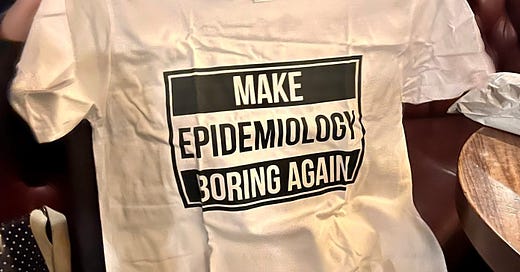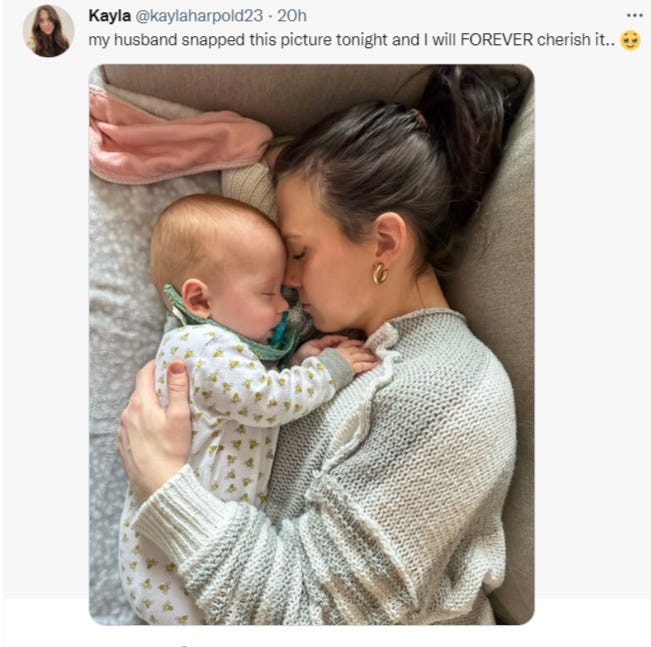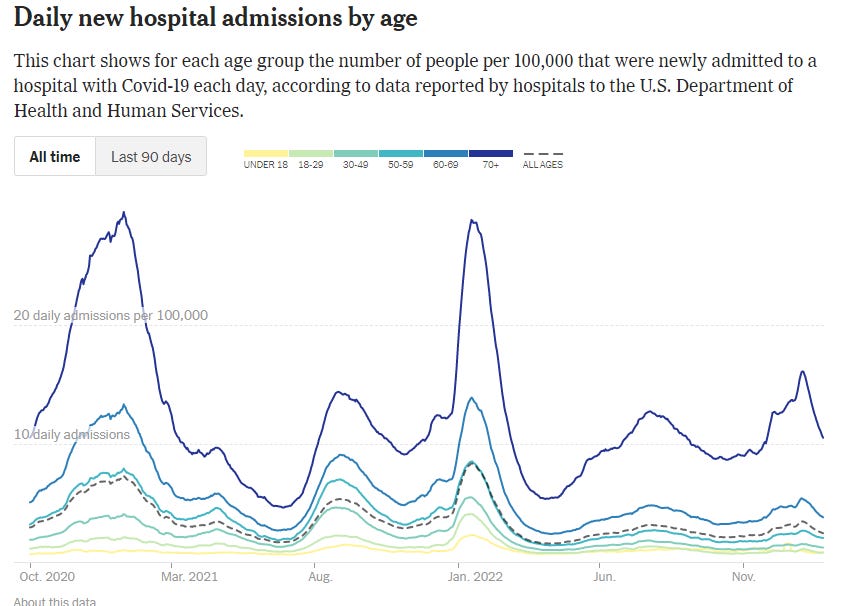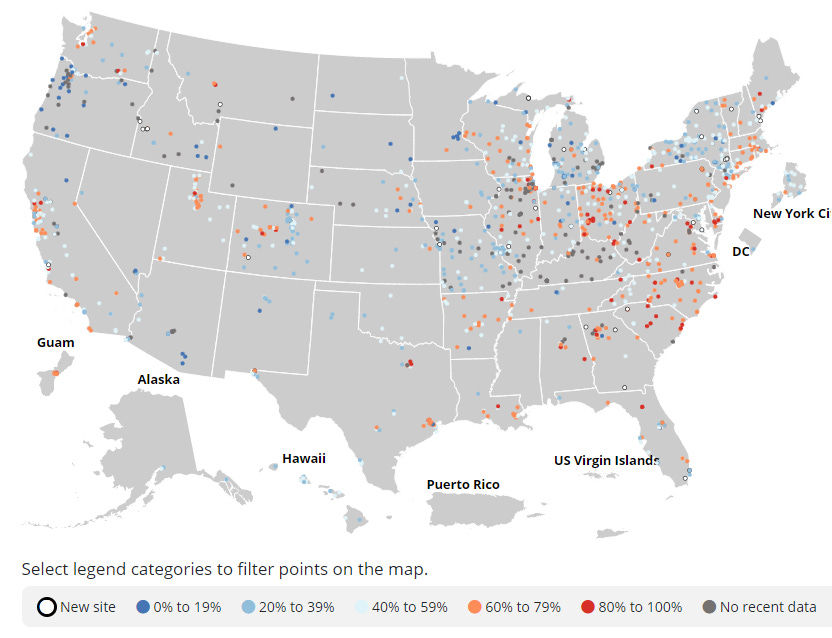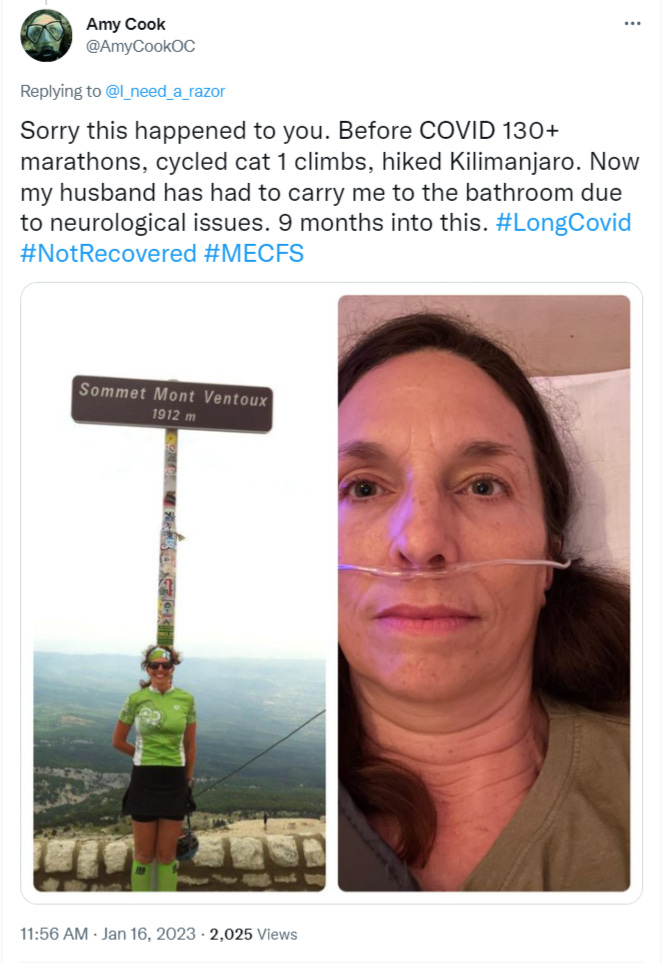COVID news 1/28/23
Hi all,
This week, XBB.1.5 has increased from 49% of cases last week to 61% of cases this week in the United States. XBB.1.5 represents almost all of the cases in the northeast, but after the holiday surge, we are starting to see cases and hospitalizations stabilize and start to decrease. Wastewater virus levels across the US are slowly starting to improve. Our collective immunity wall is helping us fight this variant. This is good news as Evusheld and other monoclonal antibodies no longer are effective against the new subvariants like XBB.1.5. World COVID case numbers are starting to decrease as well although we do not know about China as data is not being reported.
Bivalent booster
The FDA had a meeting yesterday and proposed moving towards annual mRNA Covid vaccination similar to the annual flu shot. However, COVID is not the same as the flu. COVID surges do not happen only in the winter time and so far, data shows that vaccines and boosters tend to protect well for only about 4 to 6 months. The FDA was unclear on whether adults over age 50 and people who are immunosuppressed will be able to get the updated booster more than one time per year. I anticipate that there may be some changes to this plan after further debate.
More studies this week show that the bivalent booster works well against severe Omicron infections, including the Q1.1 and XBB variants. A new study in the New England Journal of Medicine showed very clearly that the bivalent booster protects significantly more against severe Omicron infections compared to the original monovalent boosters. This makes sense since the Omicron variant is very different from the original virus. Although the FDA recommended vaccination once per year, the CDC states on their website “Talk to your doctor about getting an updated COVID-19 vaccine if your last dose was before September 2022.” Mixed messaging from the FDA and CDC will not help booster uptake.
The CDC reported this week on reasons why people did or did not get the updated bivalent booster. Only 15% of eligible people within the United States have gotten the bivalent booster despite many studies showing that it protects much better against severe disease with the new variants. In the CDC survey:
23% did not know they were eligible for a bivalent booster
19% did not know the bivalent boosters were available
19% thought that they did not need a booster because they were immune to COVID.
We need better and more consistent messaging in order to improve protection.
Regarding vaccines, India announced yesterday the launch of their COVID nasal vaccine program using technology licensed from Washington University in St. Louis. Nasal vaccines block infections by stopping the virus from entering the body. Unfortunately, the United States is not yet offering the nasal vaccine, but an article from October 2022 shows that Ocugen has licensed the Covid nasal vaccine and plans on eventually making it available in the United States, Europe, and Japan. It would be nice to have a nasal vaccine that blocks SARS-CoV-2 infection now.
A very good article came out yesterday in the New York Times regarding rapid antigen home tests. Rapid home antigen tests still work against the new subvariants like BQ.1.1 and XBB as long as a person tests correctly and if they repeat tests 48 hours after a negative test. A new study from the University of Massachusetts shows that with rapid antigen tests, if a rapid test is negative, it is best to test several times 48 hours apart. People with symptomatic COVID infections should test twice, 48 hours apart (for 93% sensitivity) and people with possible asymptomatic COVID infection after exposure should test three times at 48 hour intervals to get to 79% sensitivity. The FDA announced back in November 2022 that if you have a negative rapid antigen home COVID test, you should repeat it after 2 to 3 days. Children as young as age 4 can accurately swab themselves for a rapid home antigen test if given proper instruction.
Virus levels may be lower at the beginning of a COVID infection and therefore may not be picked up on rapid home tests. Rapid antigen tests pick up the virus when levels are high enough to be infectious to others. If someone is at higher risk for severe COVID because they are over age 50 or they have certain medical conditions and their rapid antigen home test is negative, it may be best for them to get a PCR test (lookup PCR testing sites here). PCR tests will tell if the virus is present even at low levels allowing the higher risk person to start Paxlovid sooner which can help protect them against severe infection.
Kids
The FDA meeting from yesterday showed that babies under the age of six months were being hospitalized at a high rate from Omicron infections. For this reason, maternal vaccination is very important as it can help protect young infants from COVID infections and hospitalization. A new nationwide retrospective cohort study in France shows that there is a newly discovered post-acute Covid syndrome in children that can cause kidney disease ( tubulointerstitial nephritis) with eye inflammation (uveitis). The average age of affected children was 14 years old.
Long COVID
Recent data shows that 5% of the US population is struggling with activity limitations due to Long COVID. Overall, Long COVID cases are less frequent than in the beginning of the pandemic before vaccination, but there are an estimated 500,000 to 4,000,000 people out of the workforce due to Long COVID in the United States.
A prospective study of university students, faculty and staff at George Washington University showed that 36% of infected people developed Long COVID. Three-quarters of respondents were students and the median age was 23 years old. The study showed that vaccination plus a monovalent booster decreased the risk of Long COVID by half compared to those vaccinated without the booster or to unvaccinated people. More symptoms during the acute COVID infection in this study was associated with a higher risk for long COVID.
Two-year follow-up of PASC (Long COVID) patients at a hospital in Strasbourg, France, showed that rehab and therapy helped long COVID patients with shortness of breath, anxiety and chest pain symptoms. However, rehabilitation did not improve fatigue, neurocognitive symptoms, or musculoskeletal pain. After almost two years of Long COVID, one-third of patients were still unable to work. The researchers noted that “relatively simple actions such as a phone call might be very useful to reduce [Long COVID] patients’ feelings of abandonment.” A study of New York State Workmen’s Compensation showed that 18% of people were not able to return to work because of long COVID. As Harvard economic Professor David Cutler notes, the report from New York’s from New York State shows that “even if COVID deaths are down, COVID is not over, and it won’t be for some time.”
One of the possible causes of long Covid is viral persistence in the body long after the acute COVID infection. The SARS-CoV-2 virus has been seen in the gastrointestinal tract (intestines, stomach, gallbladder, and appendix), in fat tissue, the brain and other tissues long after an acute COVID infection. A new study shows that SARS-CoV-2 infection can also persist deep in the structural parts of the lungs even after multiple negative nasopharyngeal and bronchoalveolar lavage PCR tests, with persistent SARS-CoV-2 virus seen in bronchial cartilage chondrocytes and para-bronchial gland epithelial cells and in some patients, vascular pericytes and endothelial cells. A new study in Nature Immunology shows that immunological dysfunction can persist for at least eight months after an initially mild to moderate SARS-CoV-2 infection. Some physicians have noted that people are getting unusual infections weeks or months after having a COVID infection which may be related to prolonged immune dysfunction.
In non-COVID news, a study of biobank data from Finland and England showed 22 significant associations between certain viral infections and the later risk of developing a Neurodegenerative disease (NDD) such as Parkinson’s disease, Alzheimer’s disease, Multiple Sclerosis, ALS, and dementias up to 15 years after viral exposure. Viruses that cause intestinal infections and varicella zoster which causes chickenpox were found to increase the risk for more than one of these neurodegenerative diseases. Influenza was significantly associated with five of the six neurodegenerative diseases. Viral encephalitis had a very large effect on future Alzheimer’s disease. After the 1918 Spanish flu epidemic, many more people than expected developed Parkinson’s disease. These findings are concerning as we do not yet know what effect COVID infections will have on neurodegenerative diseases like Parkinson’s and Alzheimer’s disease in the future.
There have been shortages of eggs in supermarkets which is related to a large outbreak of Avian flu. Eating cooked eggs and chicken is safe. However, scientists are following this outbreak closely after a recent report from Spain showed that there was mammal-to-mammal transmission of a mutated version of Avian flu in minks.
Finally, in some positive news, a voice controlled robot exoskeleton from Wandercraft has been approved by the FDA for stroke patient rehabilitation. An off-label use for this device potentially could help paraplegic people to walk. And finally there was a sweet story in the New York Times about farmer Hody Childress who secretly paid for his neighbors’ prescriptions if they could not afford them for many years. After his death, the town’s pharmacist let people know that Mr. Childress had been their longtime benefactor.
Have a good weekend,
Ruth Ann Crystal MD
Twitter: https://twitter.com/CatchTheBaby
Other news:
A sweet photo on Twitter
1/23/23 Engadget: FDA clears Wandercraft's exoskeleton for stroke patient rehab https://buff.ly/3XOtvX0
This voice controlled robot exoskeleton can help some people with paraplegia to walk.
1/24/23 Katelyn Jetelina: Why are there no eggs? Avian flu and keeping human risk low
There is a large outbreak of Avian flu, an H5N1 virus now.
Eating eggs and chicken, if you can find them, is safe.
In Spain, there was mammal-to-mammal transmission of the Avian flu in minks from a mutated H5N1, so scientists are keeping a close eye on this Avian flu outbreak.
1/25/23 CNN: Recently identified unusual inflammatory disease VEXAS syndrome may be more common than thought, study suggests https://buff.ly/3ZZHPOa
VEXAS syndrome is related to the UBA1 gene.
Fairly common. VEXAS syndrome affects:
1 in 4,269 men older than 50 years
1 in 26,238 women older than 50 years
1/25/23 AP: Amazon launches a $5 monthly subscription prescription drug service https://buff.ly/3XVNvqq
RxPass, a subscription service for customers who have Prime memberships. People will pay $5 a month to fill as many prescriptions as they need from a list of about 50 generic medications.
1/25/23 Nature: A wearable cardiac ultrasound patch imager https://buff.ly/3H1a4TO
Wearable ultrasound patch that can read continuous, real time images of the heart (echocardiogram) with automated processing.
Via Meaghan Kall: “Make Epidemiology Boring Again” t-shirt
Positive news:
1/25/23 NY Times: A Farmer Secretly Paid for His Neighbors’ Prescriptions for Years
Hody Childress brought cash every month to a pharmacist in Alabama, asking her to use it to help people buy medicine if they couldn’t afford it. The town learned of the arrangement only after his death.
COVID news:
https://medriva.com/charts/world-monitor.php
World
https://medriva.com/charts/usa-monitor.php
US reported cases
https://www.nytimes.com/interactive/2021/us/covid-cases.html
US cases
Hospitalization have really decreased
Variant monitoring:
XBB.1.5 went from 49% last week to 61% this week.
Hospitalizations are decreasing though.
Wastewater Monitoring:
CDC Wastewater Monitor https://covid.cdc.gov/covid-data-tracker/#wastewater-surveillance
Biobot: https://biobot.io/data/
Sewer Coronavirus Alert Network (SCAN) project by Stanford University:
Lots of discussion this week about the FDA meeting about future boosters.
1/23/23 STAT News: FDA scientists propose an annual Covid shot matched to current strains https://buff.ly/3XvJl8Z
For people who are older or immunocompromised, the FDA may recommend two annual doses of the revised shot.
1/23/23 Washington Post: FDA proposes switching to annual coronavirus vaccine, mimicking flu model https://buff.ly/3D8md8v
1/26/23 Katelyn Jetelina: Annual COVID-19 booster? FDA cliff notes https://buff.ly/3Raiv3T
Review of the FDA meeting today.
Hospitalizations:
For pregnant people, maternal vaccination is very important because as many babies under age 6 months are being hospitalized with COVID now as are people aged 50 to 64 years.
Bivalent booster:
Adults who received a bivalent booster had 3x lower risk of hospitalization.
People who got the bivalent booster had a 2x lower risk of death than people vaccinated without a bivalent booster.
Stroke risk not seen:
Initially there was a concern for a possible slightly increased risk of stroke with the Pfizer bivalent booster, but last week the risk appeared not to be increased. Other countries in Europe and Israel that use the Pfizer vaccine have not see any increased stroke risk.
FDA proposed:
Annual flu shots where strain is decided in February for a fall influenza vaccine.
Annual mRNA COVID shots where strain is decided in June for a September rollout.
Questions to be answered still:
If the new boosters will be updated once a year, could older adults get a booster if a new surge is detected?
If a new variant is discovered, what will be done?
1/26/23 MedRxiV (France): Acute tubulointerstitial nephritis with or without uveitis: a novel form of post-acute COVID-19 syndrome in children https://buff.ly/3j9vF4F
French nationwide retrospective cohort study of children shows a new post-acute COVID syndrome causing kidney disease and eye inflammation after a COVID infection.
Average age was 14.
1/26/23 Bharat Biotech launched their COVID nasal vaccine today using technology licensed from Washington University in St. Louis. Nasal vaccines protect by stopping the virus from entering the body.
From October 2022:
10/4/22 FiercePharma: Ocugen licenses COVID nasal vaccine that has been approved already in India https://buff.ly/3e3sskL
Recombinant replication-deficient adenovirus vectored nasal COVID vaccine
Ocugen licensed it from Washington University (St. Louis) for U.S., Europe and Japan.
Bharat Biotech has already licensed it for India.
1/26/23 NY TImes: Do Rapid Antigen Tests Still Work? https://buff.ly/3XHCvxj
Yes, if you use them correctly and repeat tests after 48 hours.
Rapid antigen tests show when you are contagious with COVID rather than if you have a COVID infection.
The rapid antigen tests are still accurate with newer variants because they test for the nucleoprotein of the virus instead of the spike protein. Most mutations are in the spike protein.
If you think that you have COVID, but test negative on rapid antigen tests, repeat a test after 48 hours.
However, if you are over the age of 50 or have a medical condition that makes you at higher risk for a COVID infection, get a PCR test as soon as possible so that you can start Paxlovid. Paxlovid can reduce the risk of severe illness, but the medication needs to be started within the first five days of a COVID infection.
1/23/23 MedRxiV (U Mass): Performance of Rapid Antigen Tests (Ag-RDT) to Detect Symptomatic and Asymptomatic SARS-CoV-2 Infection https://buff.ly/3HxDJWe
For symptomatic COVID infection, testing on rapid antigen tests (Ag-RDT) twice 48-hours apart had a sensitivity of 93.4%
For asymptomatic COVID infection, testing twice 48 hours apart had a sensitivity of 62.7%, but improved to 79.0% with testing three times at 48-hour intervals.
11/17/22 FDA: At-Home COVID-19 Tests-Reduce Your Risk of False Negative Results https://buff.ly/3HAAMnV
"The U.S. Food and Drug Administration (FDA) is advising people to perform repeat testing, also called serial testing, following a negative result on any at-home COVID-19 antigen test, to reduce the risk an infection may be missed (false negative result) and to help prevent people from unknowingly spreading the SARS-CoV-2 virus to others. The FDA recommends repeat testing following a negative result whether or not you have COVID-19 symptoms."
8/26/22 JAMA: Concordance of SARS-CoV-2 Results in Self-collected vs Health Care Worker https://buff.ly/3XVWKqK
With instruction, children as young as age four were able to swab themselves correctly, with test results matching a health care worker’s swabs 98% of the time.
1/25/23 Lancet Europe: SARS-CoV-2 variant-related abnormalities detected by prenatal MRI: a prospective case–control study https://buff.ly/403koDB
COVID infection in pregnancy
Both pre-Omicron (P = .008) and Omicron (P = .016) groups showed abnormalities in the form of a globular placenta compared to control cases.
Pre-Omicron group:
Pre-Omicron placentas were significantly thickened and showed significantly more frequent lobules (P = .046), and hemorrhages (P = .002).
25% of the pre-Omicron group had fetal growth restriction.
1/20/23 Neuron: Virus exposure and neurodegenerative disease (NDD) risk across 2 national biobanks from Finland and the UK https://buff.ly/3wpvd5w
Researchers compared data from the Finnish biobank to the UK biobank and found 22 significant associations between certain viral infections and the later risk of developing a NDD (Parkinson’s disease, Alzheimer's disease, Multiple Sclerosis, ALS, Generalized Dementia, Vascular Dementia) up to 15 years after viral exposure.
Viral encephalitis and Alzheimer’s disease had the largest effect.
Influenza (with or without pneumonia) was significantly associated with five of the six neurodegenerative diseases studied.
Viral encephalitis, intestinal viral infections, and varicella-zoster virus were also significant and replicated for more than one NDD.
Epstein-Barr virus and Multiple Sclerosis association was confirmed in these databases.
For the diseases that have vaccines, vaccination may be a way to reduce some risk of neurodegenerative disease.
Analysis of the above study:
1/23/23 Nature: Massive health-record review links viral illnesses to brain disease
Study ties common viruses such as Flu to Alzheimer’s and other conditions — but the analysis has some limitations.
Bivalent Booster work
1/25/23 NEJM: Effectiveness of Bivalent Boosters against Severe Omicron Infection
Bivalent booster protects significantly more as compared to the original vaccine booster. Easy to see on the graph below.
Benefit for all ages 12+ for 15 - 99 days after bivalent booster dose.
1/25/23 CDC: Bivalent mRNA Booster Dose Vaccine Effectiveness in Preventing Symptomatic Omicron BA.5 and XBB/XBB.1.5 Infection https://buff.ly/3ww7sIV
The updated bivalent booster vaccine helps prevent symptomatic COVID infection from XBB variants for at least the first 3 months in people who had previously received 2 to 4 monovalent (the original vaccine) doses.
1/25/23 NEJM: Neutralization of BA.4–BA.5, BA.4.6, BA.2.75.2, BQ.1.1, and XBB.1 with Bivalent Vaccine https://buff.ly/3jcGvqH
Neutralizing antibody (nAb) levels against BQ.1.1 and XBB.1 after a bivalent booster were several fold higher than nAb seen with the original vaccine.
1/23/23 CDC: Reasons for Receiving or Not Receiving Bivalent COVID19 Booster
Survey of vaccinated US adults:
23% did not know they were eligible for a bivalent booster
19% did not know the bivalent boosters were available
19% thought that they didn't need a booster because they were immune to COVID
Long COVID
1/26/23 CDC: Post Acute Sequelae (PASC or Long COVID) in a University Setting
Prospective study of university students, faculty and staff at George Washington University showed that 36% developed Long COVID.
Vaccination plus a monovalent booster was associated with almost half of the risk of Long COVID compared to vaccination alone or to unvaccinated people.
75% of respondents were students and the median age was 23 years old and were primarily healthy with few underlying health conditions.
More symptoms during acute infection was associated with a higher risk for long COVID.
“Because long COVID can greatly interfere with the ability to learn or work, classroom or job accommodations, such as modifying academic and workplace policies, flexible scheduling, changing workplace environment, enabling remote or alternative learning, and modifying job responsibilities, are recommended for those having long COVID.”
1/27/23 KFF: Long COVID: What Do the Latest Data Show? https://buff.ly/3Y1vZRY
5% of the adult population is struggling with activity limitations from long COVID.
Among people who currently have long COVID, many have trouble accessing the health care they need.
Overall, there has been a decline in Long COVID, but the rate of long COVID among people who have had COVID remains high.
Among people with long COVID, 79% report having limitations to their day-to-day activities and 27% characterize the limitations as significant.
Estimates of the effects of long COVID on the workforce range from 500,000 or possibly even fewer to as many as 4 million.
1/25/23 Medscape: Q&A With Long COVID Patient, Researcher Julia Moore Vogel, PhD: Treatments Lagging https://buff.ly/3XV6zp1
"It is really crucial, for those who don't have long COVID, to take it into account when you're making your risk calculations. When you're thinking: Am I going to wear a mask here? or Am I going to go to that bar?
"Really consider the possibility that if you get COVID, you have a 10% chance of getting long COVID. And if you get long COVID, you have a 25% chance of not being able to work anymore or being so ill that you can't work anymore and you may lose your health insurance.
"The compounding effects are absolutely devastating, and I think that's under-factored-in to the general risk calculations of the public.
1/24/23 NY Times: Long Covid Is Keeping Significant Numbers of People Out of Work, Study Finds https://buff.ly/3XLu97A
New analysis of workers’ compensation claims for Long COVID in New York State.
More than a year after contracting the coronavirus, 18% of long Covid patients had still not returned to work, more than three-fourths of them younger than 60, the analysis found.
Since 2020, Long COVID claims have decreased with the advent of COVID vaccines.
David Cutler, an economics professor at Harvard who has researched the cost of long Covid and was not involved in the study, “the report shows that even if Covid deaths are down, Covid is not over, and it won’t be for some time.”
Viral persistence:
1/23/23 J of Path: Persistent SARS‐CoV‐2 infection in patients seemingly recovered from COVID‐19 https://buff.ly/3QXTglf
Post-mortem analyses in 27 consecutive patients who had apparently recovered from COVID-19 but had progressively worsened, despite being PCR negative.
SARS-CoV-2 infection can persist significantly longer than suggested by nasopharyngeal and bronchoalveolar lavage PCR-negative tests, with persistent infection of bronchial cartilage chondrocytes and para-bronchial gland epithelial cells and in some patients, vascular pericytes and endothelial cells.
1/23/23 J Clin Med (Strasbourg): Two-Year Follow-Up of Symptoms and Return to Work in Complex Post-COVID-19 Patients (PASC or Long COVID) https://buff.ly/3WvBneR
Small study
Rehab and therapy:
Helped dyspnea, anxiety and chest pain symptoms
Did not improve fatigue, neurocognitive disorders, muscles and joint pain, which were more common symptoms.
Work:
2/3 of the patients returned to work either partially or fully.
1/3 remained too symptomatic to work as late as 22 months after COVID.
All patients greatly appreciated the second phone consultation.
“Conclusions: In such complex situations, besides early and adapted rehabilitations and psychological help allowing better symptom management, relatively simple actions such as a phone call might be very useful to reduce patients’ feelings of abandonment.”
1/24/23 Nature Immunology: Immunological dysfunction persists for 8 months following initial mild-to-moderate SARS-CoV-2 infection https://buff.ly/3H4uhII
At 8 months after infection, people with Long COVID (LC) had:
highly activated innate immune cells,
lacked naive T and B cells and
showed elevated expression of type I IFN (IFN-β) and type III IFN (IFN-λ1).
Combinations of the inflammatory mediators IFN-β, PTX3, IFN-γ, IFN-λ2/3 and IL-6 were associated with LC with 78.5–81.6% accuracy.


1/22/23 Australia: XBF
1/20/23 Forbes: Eric Topol MD answers common questions on Long COVID:
Leading COVID expert says not enough is being done to help long haulers: “There’s no excuse for this” https://buff.ly/3QW0S7P
